Study documents relationships between primary productivity and living marine resources-based economics for U.S. regional and 64 international large marine ecosystems

Globally and in the United States of America, living marine resources (LMRs) and associated fisheries are important contributors to ocean economies. Total LMR-related revenue and employment have increased over the past decades, with U.S. marine fisheries currently valued at $210 billion and contributing on average ~ 2.5 percent of the U.S. ocean gross domestic product.
Fisheries economic production is limited by factors including ecosystem-level constraints that have not been fully explored in past investigations. As oceans continue to undergo global change, environmental and ecological factors are anticipated to become more limiting on seafood production and affect marine economies. Addressing these future challenges will require broader management approaches that consider both marine ecosystem dynamics and human dimensions in concert. Here we examine these socio-ecological relationships more closely for both US and all International Large Marine Ecosystems (LMEs).
Seminal works have addressed the value and sustainability of natural capital, including its connections to multiple marine ecosystems, but have not always examined limiting factors. Previous studies have determined that sustainable fisheries harvest is related to the level of primary production (i.e., basal organic production) available within a given ecosystem, with this limitation being a primary consideration when accounting for ecosystem overfishing.
Investigations in estuarine and lacustrine environments have similarly quantified the influence of nutrient loading (which impacts primary production) on fish production, with some hinting at ultimately limiting the magnitude of fisheries economics.
Yet there have been no examinations of the relationship between fisheries economic performance and primary productivity for marine waters. Theoretical studies, marine ecosystem models, and empirical examinations have estimated transfers of primary and higher-order production to biomass throughout trophic levels, identified shifts and perturbations in trophic composition, and demonstrated how LMR production and associated fisheries landings are ultimately limited by ecosystem production. These relationships have also been shown to differ among regions and are influenced by multiple human-related and environmental factors.
This article – adapted and summarized from the original publication [Marshak, A.R. and J.S. Link. Primary production ultimately limits fisheries’ economic performance. Sci Rep 11, 12154 (2021)] – documents and details novel relationships between primary productivity and living marine resources (LMRs)-based economics for U.S. regional marine ecosystems and 64 international large marine ecosystems (LMEs). Intermediate relationships between production, total biomass, fisheries landings, revenue, and LMR-based employment are also elucidated.
Study setup
To evaluate relationships between components of the pathway proposed by Link and Marshak, from primary productivity, total surveyed fish and invertebrate biomass, fisheries landings, economic revenue, and living marine resource (LMR)-based employment for US regions (as defined by regional fishery management council and NOAA jurisdictions) and international LMEs, various methods and data sources were used, available at the original publication.
Results and discussion
When investigating these relationships more closely, we find strong positive relationships in U.S. LMEs for total fisheries landings as a function of average primary productivity rates (Fig. 1c). Highest landings during this period (years 1998 to 2014) were observed in the most productive U.S. regions (i.e., U.S. North Pacific, Gulf of Mexico and the Northeast U.S.), while lower landings were associated with less productive tropical and subtropical areas. While other environmental factors, governance and management interventions, previous exploitation, and living marine resource status all affect regional fisheries landings, primary production accounts for a major, foundational component of this variability (Fig. 1c).
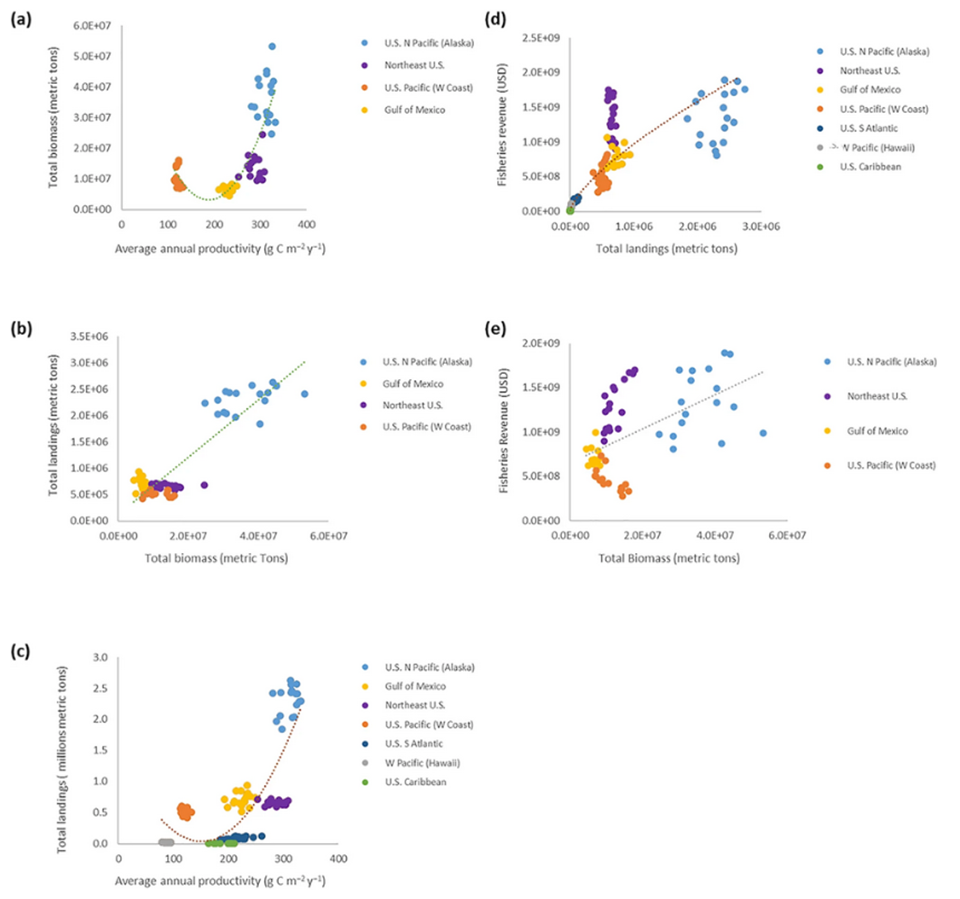
Basically, we illustrate that primary production influences total biomass (Fig. 1a), which positively affects total landings (Fig. 1b), reinforcing that primary productivity is also positively related to total landings (Fig. 1c). Total landings are related to fisheries revenue (i.e., fisheries performance; Fig. 1d), which is ultimately set by total biomass (Figure 1e) and results in the main relationship that primary productivity is strongly related to total fisheries revenue (Fig. 2).
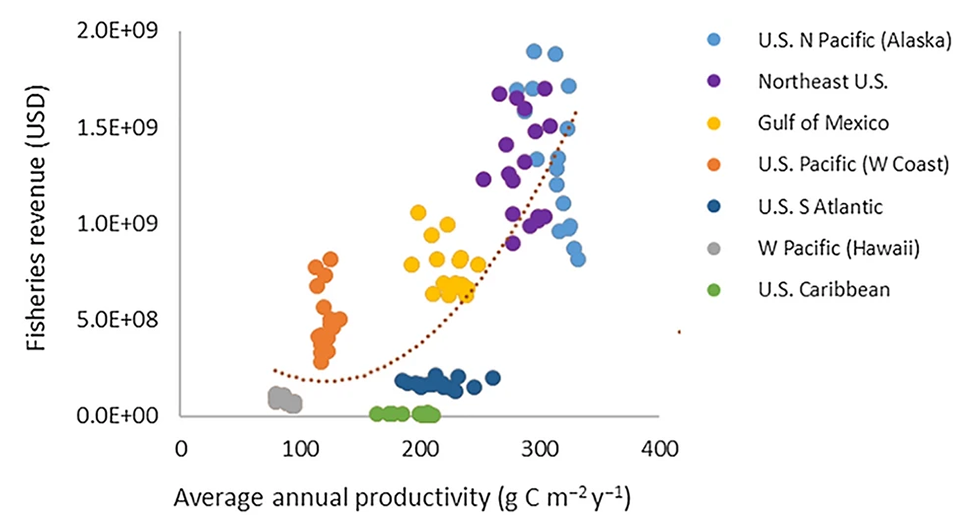
Extending these associations to recognize the positive relationship between fisheries landings and LMR-based employment (Fig. 3a) implies that primary productivity can influence regional ocean employment (Fig. 3b), and percentages thereof for an entire regional ocean-based economy (Fig. 3c, 3d).
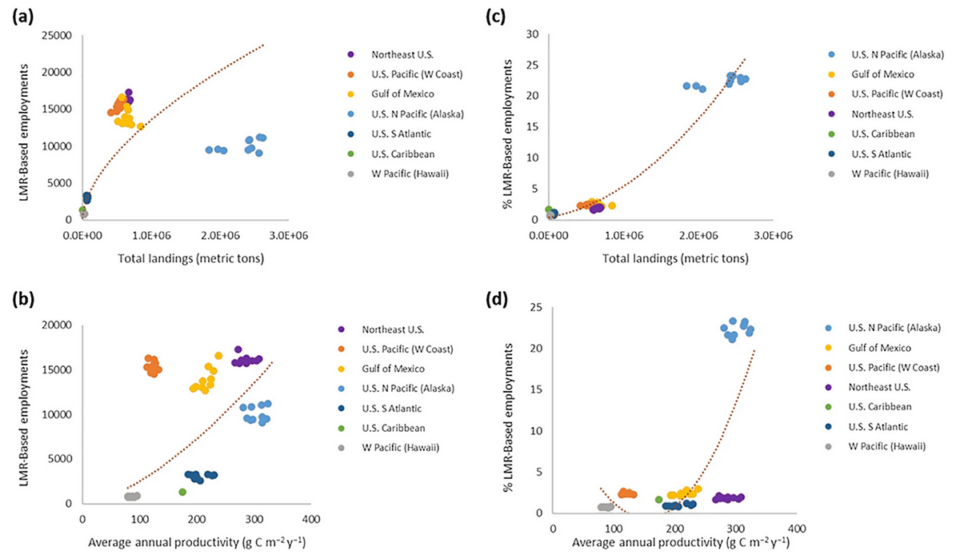
While these patterns have been demonstrated for US marine ecosystems, particularly in temperate, sub-tropical and sub-polar geographies, we also explore how broadly these relationships hold for other marine ecosystems. Examining these relationships for 64 international LMEs, we confirm that these production-dependent economic patterns are repeated (Fig. 4a–c), with a few exceptions. Two main outliers include the eutrophic Baltic Sea40, where high productivities (associated with anthropogenic nutrient loading) and low landings and fisheries value (associated with overfishing) are observed (Fig. 4a, 4b), and the Humboldt Current where high landings (with relatively low fisheries value) are found in an upwelling system with mid-range average production and low continental market value in South America for mostly small pelagic fisheries (Fig. 4a, 4c). In addition, low landings and revenue are associated with productive waters off the North Australian Shelf (Fig. 4a, 4b) due to historic exploitation, degraded ecosystem conditions, and potentially related to the increasing presence of marine protected areas.
Alternatively, highest landings and revenue in Oceania are found for the New Zealand Shelf, with mid-range productivity and where additional concerns have been highlighted regarding ecosystem condition. In general, higher fisheries landings and revenue were observed off Asia, Europe, Africa, and South America, where mid to high productivities occurred (Fig. 4a–c). The salient point is that despite these caveated instances, the pattern of primary production establishing the magnitude of fishery economic performances is repeated globally.
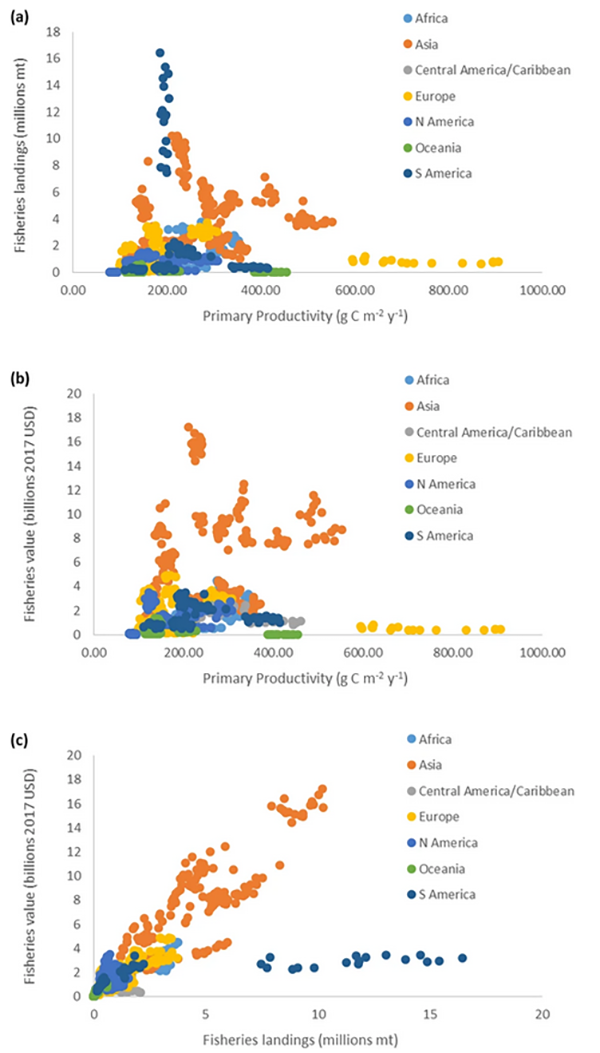
If these relationships generally hold true throughout all LMEs, then significant implications for LMR-based economics and management follow. Chiefly, these results show that for any given marine ecosystem, its associated economic performance (i.e., fisheries revenue) is ultimately limited by inherent basal ecosystem productivity, as has been demonstrated for fisheries landings. Therefore, within some systems we cannot expect their economic contributions to be as high (or to increase as readily) as in others due to the limitations of primary production.
Ultimately, some regions are inherently more productive than others, which could translate into higher economic benefits that might be sustained over greater periods of time if exploitation rates remain at or below system thresholds. In general, these relationships hold, but there are also outliers, which reinforce the importance of monitoring, understanding and knowing the particular characteristics of each system.
While regional LMR-based economies are also dependent on other human (including governance, exploitation and market interventions) and environmental factors, their dependence on system-level primary production should be recognized more strongly, particularly in terms of limiting catch and LMR-based economics. Thus, currently productive systems in the United States, such as the North Pacific and Northeast U.S., could see future climate-related changes to their basal productivities, which could extend to the sustainability of these major LMR-based economies. The same would apply to other regions around the globe.
The global ramifications of these findings are not trivial, reinforcing studies that have highlighted concerns about the future sustainability of fisheries production and economics. There is a foundational role that system productivity plays in determining ecosystem biomass, and both directly affect sustainable harvest rates and LMR-based economics throughout the majority of U.S. and international LMEs. Specifically, greater accounting for the linkages between basal production, system-level biomass, landings, ecosystem overfishing and LMR-based revenue and employment in management is integral for the successful future sustainability of marine fisheries and their dependent communities. This focus is especially warranted given that altered global primary production is predicted to occur as a result of ongoing climate change effects to the world’s ocean.
While these effects may not be observed for total, global oceanic primary production, future changes in the seasonality, distribution and composition of the phytoplankton community may alter the productivity available to higher trophic levels within LMEs, with large ramifications for fisheries-associated economies. In addition, continued natural and anthropogenic impacts to LMEs may lead to large-scale regime shifts, such as those currently observed for multiple systems, including the Baltic Sea, Benguela Current, California Current and North Sea. Redirected trophic flow and altered ecosystem structure would have significant effects on the primary production and biomass required to sustain catch, thereby affecting future harvest potential and its associated economics.
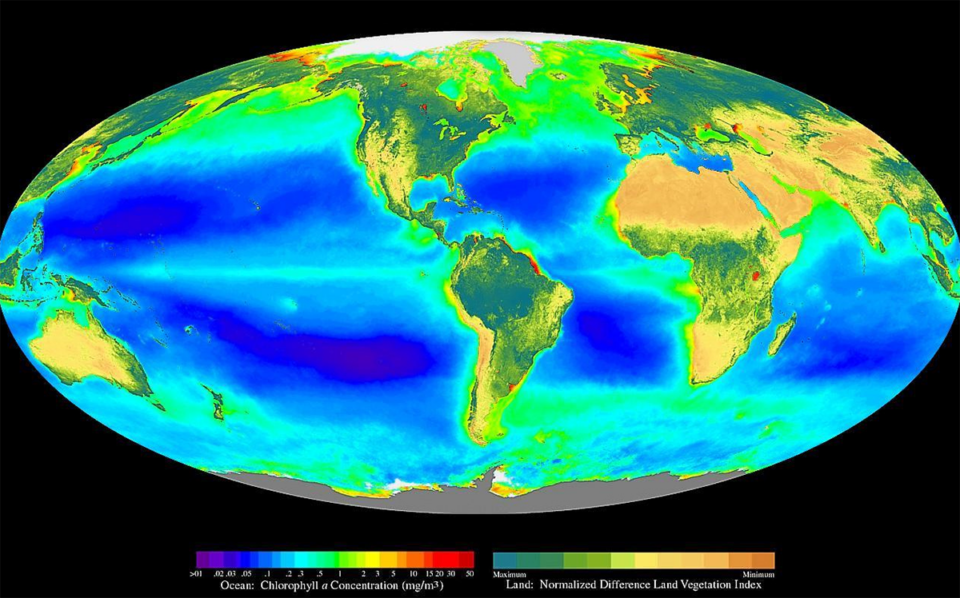
These relationships have particular application for ecosystem overfishing, where management of system-level landings, revenue and LMR-based economics are considered relative to system productivity and biomass. Efforts to prevent ecosystem overfishing, particularly in areas that have already exceeded thresholds (e.g., Northeast U.S., Gulf of Mexico, Southeast Asia, or some African LMEs) would wisely account for the relationships noted here under future management. These approaches also account for natural and human-related factors that influence system-level production, biomass, landings and economics, whose characterizations are especially important in explaining trends and interrelationships in outlier ecosystems. As compounding natural and human-related stressors continue to affect marine ecosystems, and multiple fisheries stocks remain overfished or of unknown status, the urgency for these more holistic and adaptive approaches cannot be overstated.
Global fisheries value and employment continue to increase and have remained high over the past decades. However, these trends are expected to change during the 21st century as a result of multiple factors, including climate-related production shifts, continued exploitation and consequential increases in fishing-associated costs. Global landings have effectively plateaued and together with their revenue are ultimately limited by primary production. While limited quantity and high demand may cause prices to increase by an order of magnitude for particular taxa in a given ecosystem, the associated maximum potential revenues and their variability are ultimately constrained by the amount of catch available, which itself is constrained by primary production.
Accounting for these factors and their influences and greater commitment to monitoring global primary production, especially in under-resourced areas with high human population growth, is warranted. These relationships are especially worth monitoring for marine ecosystems that contain the most lucrative fisheries resources, and in those having the greatest risks of ecosystem overexploitation; the estimation, validation and assessment of primary production dynamics is a minor cost relative to the value of those fisheries.
Perspectives
Continuing to invest in broader, ecosystem-based approaches, with a strengthened understanding of the socio-ecological connections among marine ecosystems, natural phenomena and human dimensions will allow for more thorough implementation and benefits of ecosystem-level approaches. To be able to consider these multiple factors together, a rethinking of how we view and approach both fisheries harvest and management is necessary.
Efforts to shift from a traditional single-species focus to a more comprehensive ecosystem-based approach have been underway for several decades, with concrete implementation plans for U.S. fisheries developed over the last few years. The benefits of establishing maximum biomass removal caps, such as those for groundfish in the North Pacific, continue to be observed. Their utility as a management tool for preventing ecosystem overfishing and ensuring sustainable LMR-based economics is reinforced by the findings of our study.
The needs and benefits of ecosystem-based fisheries management are gaining in awareness, acceptance and implementation; these systematic marine management approaches better allow for the accounting of interconnected environmental, ecological, economic and system-level trade-offs.
Ultimately, greater recognition that foundational primary production within an ecosystem indeed limits its sustainable harvest, and thus the associated economic performance and benefits derived from its marine resources, is key to ensuring that these connections are accounted for more effectively in management approaches.
Now that you've reached the end of the article ...
… please consider supporting GSA’s mission to advance responsible seafood practices through education, advocacy and third-party assurances. The Advocate aims to document the evolution of responsible seafood practices and share the expansive knowledge of our vast network of contributors.
By becoming a Global Seafood Alliance member, you’re ensuring that all of the pre-competitive work we do through member benefits, resources and events can continue. Individual membership costs just $50 a year.
Not a GSA member? Join us.
Authors
-
Anthony R. Marshak, Ph.D.
Corresponding author
CSS, Inc. in Support of NOAA’s National Centers for Coastal Ocean Science
National Ocean Service
National Oceanic and Atmospheric Administration
Silver Spring, Maryland, USA[118,111,103,46,97,97,111,110,64,107,97,104,115,114,97,109,46,121,110,111,116]
-
Jason S. Link, Ph.D.
National Oceanic and Atmospheric Administration
National Marine Fisheries Service
Office of the Assistant Administrator
Woods Hole, Massachusetts, USA
Tagged With
Related Posts
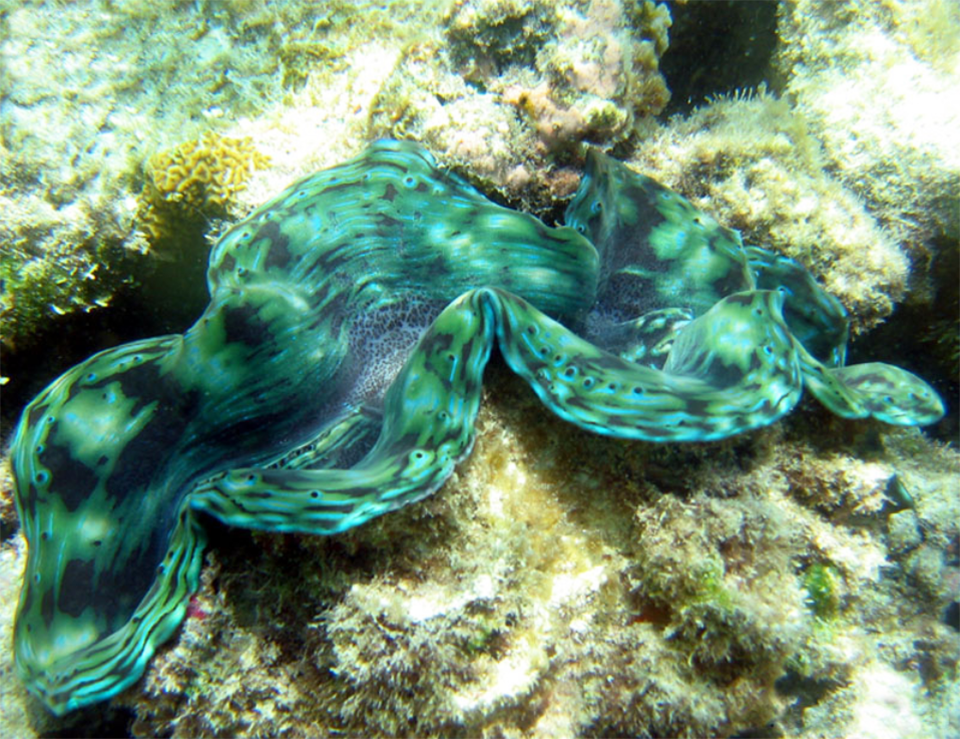
Responsibility
A global overview of restorative shellfish mariculture
A review of restorative shellfish mariculture case studies around the world to identify emergent patterns across species and ecoregions.

Fisheries
Ocean mining’s energy potential could put global fisheries at risk
Interest in ocean mining is growing, but hundreds of scientists warn that impacts may devastate existing marine industries, including fisheries.
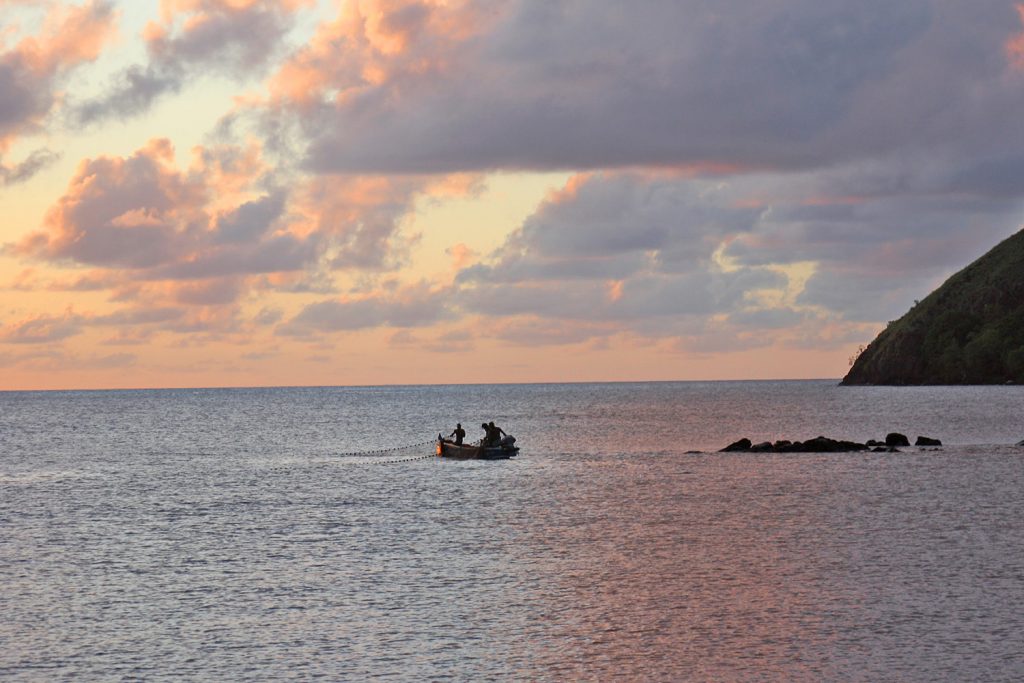
Innovation & Investment
Financing a sustainable ocean economy
A healthy environment that supports a sustainable ocean economy requires adequate financing to achieve sustained performance and governance.
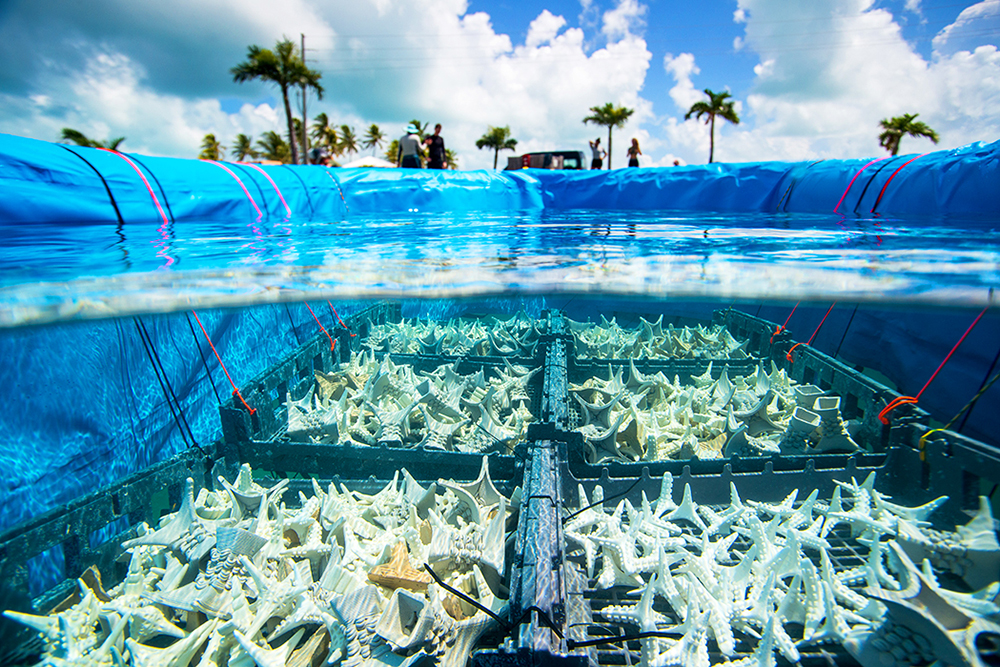
Responsibility
A wider view: Conservation aquaculture anchors coral reef restoration
Half a billion people depend on coral reefs for food, income, coastal protection and more. The need to protect and restore their biodiversity is urgent.



